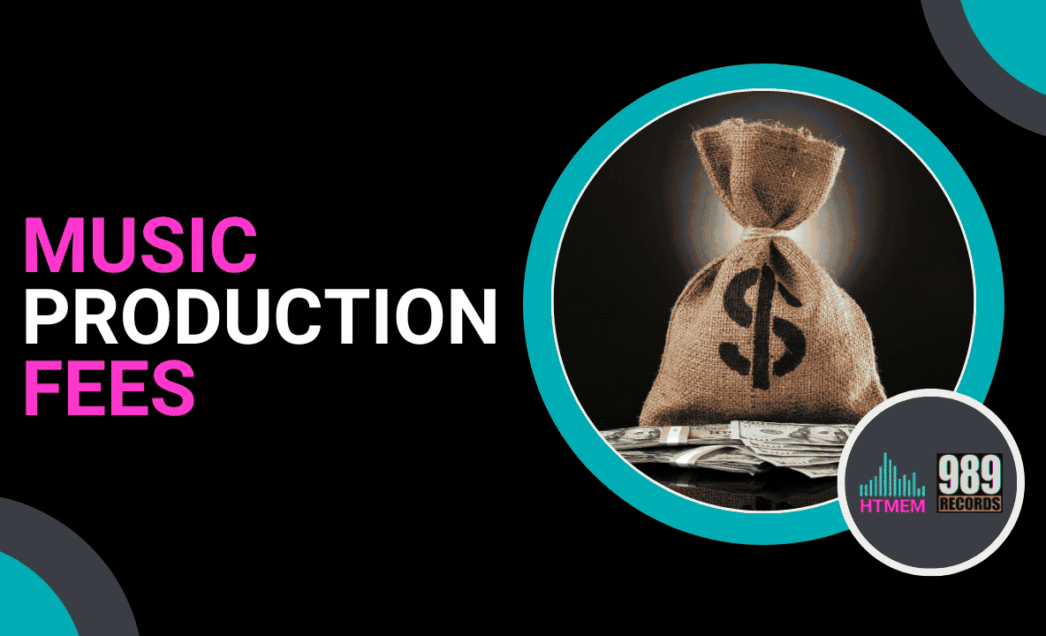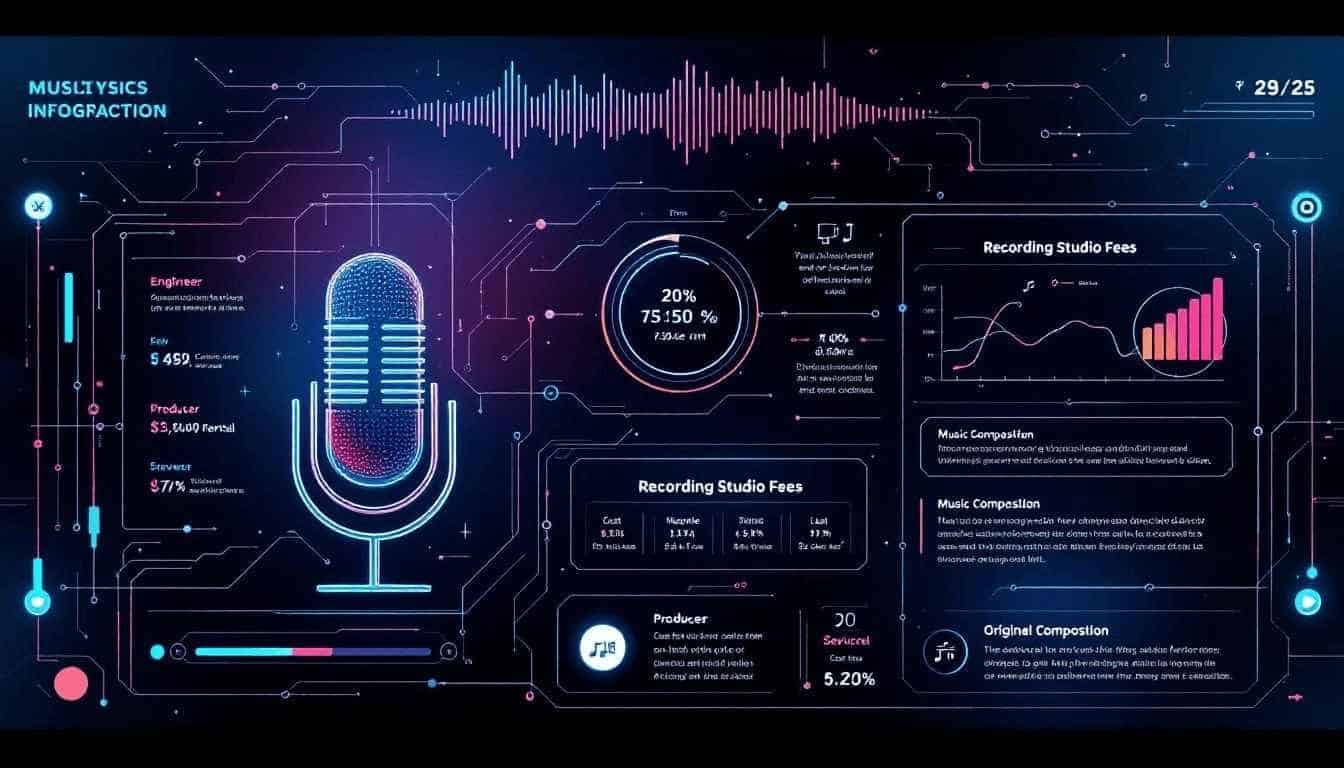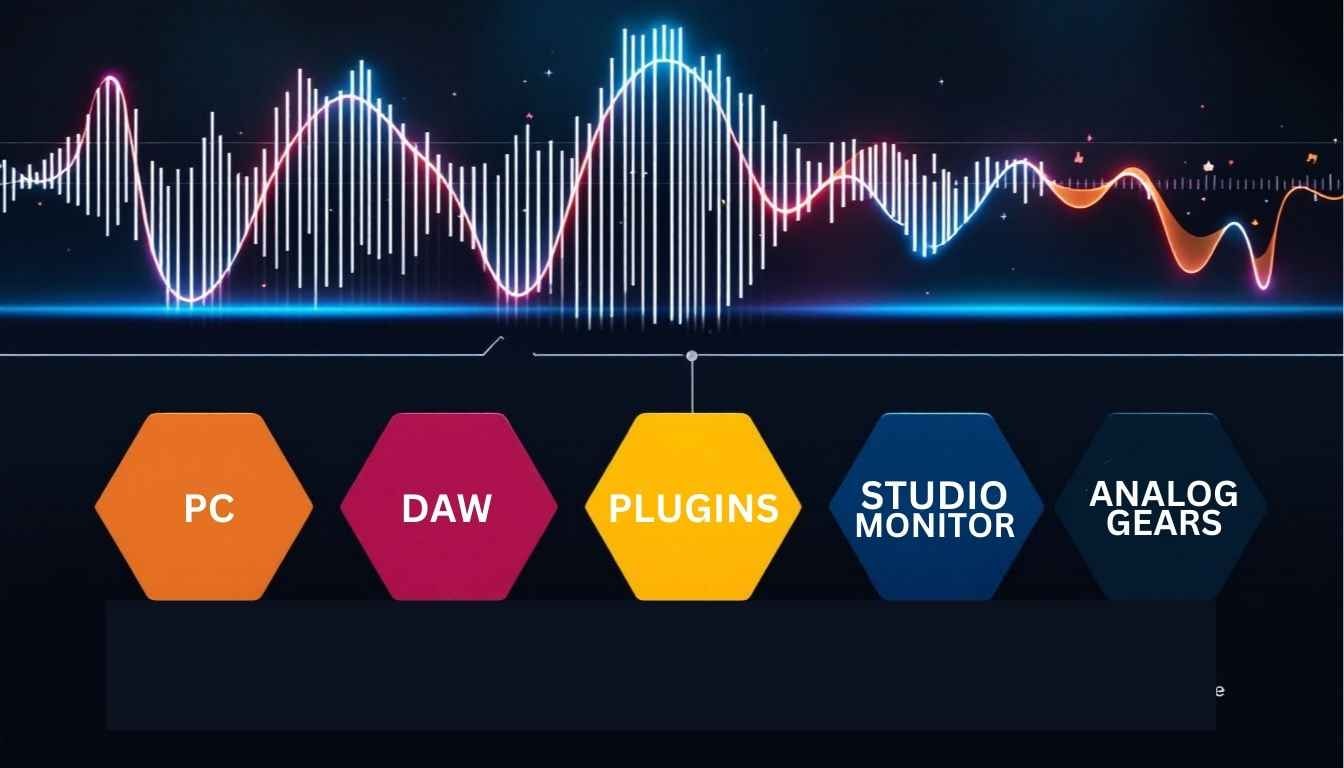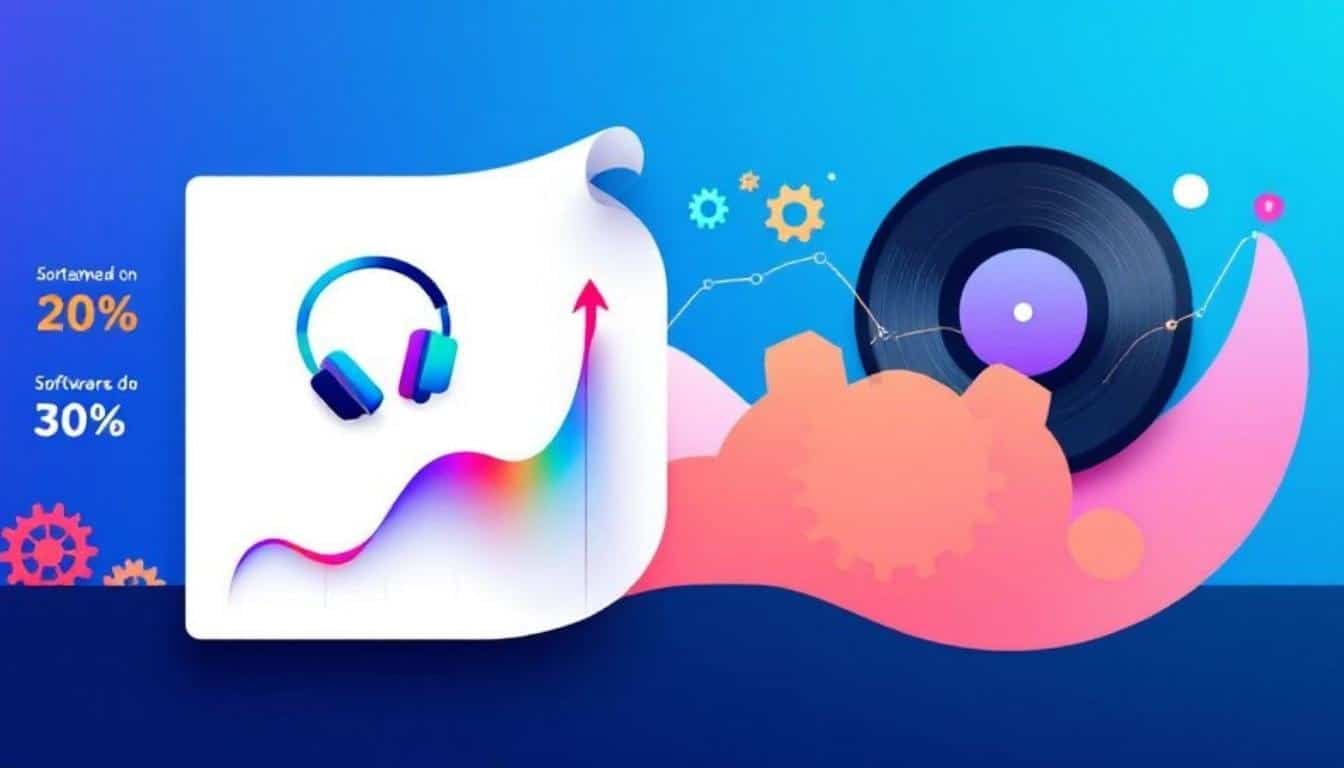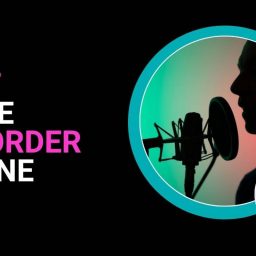Music production fees typically range from hundreds to thousands of dollars, depending on various factors.
Key costs include studio rental, equipment, session musicians, mixing, and mastering. So, in this post, we will break down these costs to help you plan your budget effectively.
In Short
- Key components of music production fees include studio rental, equipment costs, professional services, and individual project complexities influencing overall budgeting.
- Understanding the cost of studio time, including hourly rates, package deals, and additional expenses, is essential for effective budgeting.
- Budgeting tips for independent artists emphasize prioritizing expenses, leveraging free resources, and accounting for miscellaneous costs like artwork and legal fees.
Key Components of Music Production Fees
Several key cost components in music production can significantly impact your budget. The primary expenses include studio rental, equipment, session musicians, mixing, and mastering.
Each element contributes to the overall quality and professionalism of the final product.
The complexity of your project, such as the number of songs and arrangements, will also influence the total cost, with simpler projects generally costing less than more elaborate ones. Investing in high-quality studio monitors, for example, can enhance the overall sound production quality, making it a worthwhile expense in the long run.
Understanding these components and how they interact is the first step in creating a realistic budget for your music production.
Studio Time Expenses
Studio time is one of the major components of music production costs. The cost of booking a recording studio can vary widely, typically ranging from $40 to $500 per hour depending on the studio’s quality and location.
Recording a single song in a professional studio can cost anywhere from $150 to $20,000, influenced by the studio’s reputation and the services offered. Factors such as hourly rates, equipment rental, extra services, and hiring musicians can significantly influence studio time costs.
Studying all associated costs and planning before booking a recording session is essential. Familiarizing yourself with different pricing models and potential additional costs will help you budget more effectively for your studio time.
Hourly Rates vs. Package Deals
Booking studio time often involves choosing between paying an hourly rate or opting for a package deal. Hourly rates can range from $40 per hour in mid-tier studios to $200 per hour in top-tier facilities. While hourly rates offer flexibility, they can lead to higher overall costs if your recording sessions extend beyond initial estimates.
Package deals, on the other hand, provide a flat rate for a set amount of time or number of sessions, offering more predictability in your budgeting. Deciding between these options depends on your project’s scope and your budget constraints.
Additional Studio Costs
Beyond the basic hourly rates or package deals, additional studio costs can significantly impact your overall budget. Equipment rentals, for example, can add to the expenses, especially if you require specialty instruments or high-end gear. Potential overtime charges can also increase total studio costs if your recording sessions run longer than planned. Accounting for these potential additional costs is necessary when budgeting for studio time.
These associated costs and average costs can vary widely based on the studio and the specific needs of your project. Planning for these additional expenses can help avoid unexpected financial strains and keep your production within budget.
Equipment and Software Costs
Investing in the right equipment and software is crucial for music production.
Essential music production equipment can start from several hundred dollars, while a professional setup may cost thousands. Specialty instruments and advanced software plugins can vary widely in cost, from a few hundred dollars to several thousand. High-end synthesizers, for example, can cost between $1,000 and $5,000, presenting a significant investment for producers.
Distinguishing between essential and optional equipment is vital for effective budgeting. Allocating resources efficiently by distinguishing between necessary gear and optional enhancements ensures your budget aligns with your production goals.
Essential Production Gear
Essential production gear includes items that are crucial for achieving quality sound in your music production. Here are some key components:
- A basic music production computer, can cost approximately $900 or more, depending on the specifications.
- A reliable audio interface, is vital for sound quality, typically costing around $150.
- Studio monitors, which usually range from $150 to several thousand dollars.
- Good-quality headphones, starting at around $100.
The right equipment is essential for achieving quality in music production, as it directly influences the sound output. Investing in essential items provides a solid foundation for your production process.
Optional Enhancements
Optional enhancements can significantly boost efficiency and productivity in music production. These add-ons might include advanced software plugins, specialty instruments, or additional hardware that can enhance the quality of your output.
Weighing the costs against potential benefits is necessary before investing in optional equipment.
Investing in versatile equipment and software systems can lead to long-term cost savings, as they may reduce the need for frequent upgrades or replacements. Also, consider whether renting or buying equipment is more cost-effective based on usage frequency.
However, be mindful of the potential drawbacks, such as extra maintenance and possible warranty voiding.
Professional Services Fees
Professional services are another critical component of music production costs. Beyond studio fees, additional costs include mixing, mastering, and potential duplication of albums, which can add significantly to the overall budget.
Employing a professional audio engineer during recording sessions typically incurs an extra charge, often ranging from $40 to $85 per hour.
Mastering an album after recording usually costs around $100 per song or $500 for an entire album, depending on the mastering engineer.
These professional services fees are necessary for achieving a polished, industry-standard sound. Incorporating these costs into your budget ensures effective planning for the entire production process.
Hiring a Music Producer
Hiring a music producer can significantly impact your music production budget. The pricing of music producers is influenced by their experience, reputation, project scope, and additional services they may offer. Factors such as location, genre, and the scope of work involved also play a role in determining producer fees. Higher-priced producers often have significant experience with successful projects, leading to their higher fees.
The cost of hiring a music producer can range from $300 to $2,000 per song, with highly recognized producers starting at $5,000 or more. Entry-level producers typically charge up to $500 per song, while newer producers might charge anywhere from $200 to $1,500 per track.
Evaluating a producer’s solid track record and portfolio ensures they align with your artistic vision.
Mixing and Mastering Rates
Mixing and mastering are crucial processes in music production that significantly impact the final sound quality of your recordings. Mixing engineers typically charge between $100 and $1,000 per song. Consider that these services are essential for achieving a professional sound and making a lasting impression in the music industry.
Budgeting appropriately for mastering services is crucial, as they enhance the final output. High-quality mixing and mastering are key to producing music that stands out and resonates with listeners.
Session Musicians and Vocalists
Hiring session musicians and vocalists can add a unique and professional touch to your music production. These professionals are hired to enhance music tracks by providing skilled instrumentations and vocal performances. The costs for hiring session musicians vary based on their experience, the number of musicians required, and the complexity of the parts they are playing.
Although hiring additional musicians can obviously increase studio costs, budgeting for these services ensures high-quality recordings and production value.
Payment Structures in Music Production
Payment models in music production can vary widely, encompassing flat fees, royalties, and hybrid structures tailored to different projects. Flat fee payments offer immediate compensation, making them appealing for projects with limited budgets and timelines. However, royalty-based payments can provide long-term financial benefits, especially when the music generates significant ongoing usage and audience engagement.
Blending payment models, such as combining flat fees with royalties, allow for balancing immediate production costs with potential long-term earnings. This approach can be particularly beneficial for artists who expect significant streaming success and want to maximize their financial returns over time.
Flat Fee vs. Royalty-Based Payments
Flat fee payments offer quick compensation and eliminate the need for tracking royalties, making them suitable for limited budgets and tight timelines. However, royalty-based payments can provide long-term financial benefits, especially when the music achieves significant streaming success.
For example, the break-even point for a $1,000 flat fee based on streams is approximately 2.5 million streams.
Evaluating a project’s potential reach and revenue is crucial when deciding between flat fees and royalties. While flat fees provide immediate compensation, royalties can offer more substantial earnings over time if the music gains popularity.
Combining Payment Models
Strategically combining payment models can help manage music production costs. Establishing clear financial boundaries before engaging with a music producer is essential. Propose alternatives like deferred payment plans if immediate cash flow is a concern.
Utilizing free resources such as online tutorials and sample packs can significantly cut down production costs, allowing for a more flexible budget. Blending flat fees with royalties balances immediate expenses with potential long-term earnings, making it a viable option.
Budgeting Tips for Independent Artists
Budgeting is crucial for independent artists to make quality music and achieve their production goals.
Creating a manageable budget helps maximize resources effectively, allowing artists to allocate funds where they are most needed. Music production costs can vary significantly based on the project’s complexity, with simple demos costing less than full albums.
Determining a budget and maximizing resources are key aspects to consider. DIY practices can save money by allowing artists to do certain tasks themselves, such as recording, mixing, and mastering. Expenses like marketing materials and legal consultations are often overlooked in budgeting, so it’s important to account for them as well.
Prioritizing Expenses
To optimize a music production budget, prioritizing expenses is crucial. Understanding the average rates for music producers helps in budgeting effectively. Prioritize essential elements like quality instruments and recording equipment, which are crucial for achieving a professional sound.
This approach ensures that the most critical aspects of your production are covered, while less essential items can be added as the budget allows.
Leveraging Free and Affordable Resources
Leveraging free and affordable resources can significantly reduce music production costs. Have a financial plan for all expenditures and consider using online tutorials, free software, and sample packs to save money.
These resources can provide valuable tools and knowledge without the need for substantial financial investment, allowing independent artists to produce high-quality music on a limited budget.
Finding the Right Music Producer Within Your Budget
Finding the right music producer involves understanding your financial constraints while aiming for quality. The DIY approach can build skills for future projects, but a professional producer can elevate your music to a new level.
Evaluate seasoned producer portfolios to find someone whose style and capabilities align with your artistic vision, and don’t be afraid to negotiate fees and packages to stay within your budget.
By carefully selecting a producer, you can surely achieve high-quality production without breaking the bank.
Evaluating Producer Portfolios
Reviewing a producer’s previous work provides insight into their style and capabilities, helping you determine if they align with your artistic vision. Focus on the genres and styles of music a producer has worked on to see if they match your needs. An effective music portfolio includes video reels and audio playlists to demonstrate a producer’s capabilities.
Consider asking for testimonials or references from previous clients to gauge a producer’s experience, reliability, and professionalism.
Negotiating Fees and Packages
Negotiating fees with a music producer is an essential step in ensuring that you stay within your budget while getting quality production services. Clearly communicate your budget and expectations during negotiations while remaining flexible when possible.
Well-executed negotiations can lead to better deals that fit both your financial and creative needs.
Miscellaneous Costs to Consider
Miscellaneous costs often go overlooked but can significantly impact the overall budget. Common additional fees include studio time, musicians and singers, and mixing and mastering. Other specific costs associated with music production are graphic and album artwork, royalties, and legal fees.
Thoroughly budgeting for these often-overlooked expenses ensures a successful music production outcome. By accounting for these costs, you can avoid unexpected financial strains and ensure all aspects of your project are covered.
Album Artwork and Promotion
Artwork fees for visuals and promotional materials are an important consideration in music production. These costs can vary depending on the complexity and quality of the artwork, as well as the promotional strategies employed.
Allocating a portion of your budget to album artwork and promotion ensures your music is presented professionally and reaches a wider audience.
Legal Fees and Royalties
Budgeting for legal services is essential to handle contracts and ensure compliance with copyright laws. Legal consultations can protect against copyright infringement and secure necessary rights, minimizing potential legal expenses related to music production.
Reviewing contracts is essential to ensure that all legal aspects are covered, providing peace of mind and allowing you to focus on the creative process.
Summary Table
| Component | Details |
|---|---|
| Studio Time | Costs range from $40 to $500 per hour. Options include hourly rates or package deals. Additional costs may include equipment rental and overtime charges. |
| Equipment and Software | Essential gear includes computers, audio interfaces, studio monitors, and headphones. Costs vary from hundreds to thousands of dollars. Optional enhancements can include advanced plugins and specialty instruments. |
| Professional Services | Includes mixing and mastering, with costs ranging from $100 to $1,000 per song. Hiring a music producer can cost $300 to $2,000 per song, with top producers charging $5,000 or more. |
| Session Musicians | Costs depend on the number of musicians and complexity of parts. Hiring musicians adds to studio costs but enhances production quality. |
| Payment Models | Options include flat fees, royalties, or a combination. Flat fees offer immediate compensation, while royalties provide long-term benefits. |
| Budgeting Tips | Prioritize essential expenses, leverage free resources, and negotiate fees. Consider DIY practices to save costs. |
| Miscellaneous Costs | Include artwork, promotion, legal fees, and royalties. Budgeting for these ensures comprehensive financial planning. |
Summary
Understanding music production fees is essential for planning and executing a successful project. From studio time and equipment to professional services and miscellaneous costs, each component plays a vital role in the production process. By carefully budgeting and prioritizing expenses, leveraging free resources, and negotiating with producers, you can create high-quality music without overspending. Remember, thorough planning and financial management are key to achieving your production goals.
Frequently Asked Questions
What are the main components of music production fees?
Music production fees primarily consist of studio rental, equipment costs, session musicians, mixing, and mastering services. Understanding these components can help you budget effectively for your project.
How much does studio time typically cost?
Studio time typically costs between $40 and $500 per hour, influenced by the studio’s quality and location. It’s essential to consider your budget and project needs when selecting a studio.
What is the cost of hiring a music producer?
Hiring a music producer typically costs between $300 to $2,000 per song, while well-known producers can charge $5,000 or more. It’s essential to consider your budget and the experience level of the producer you choose.
How can independent artists save money on music production?
Independent artists can significantly reduce music production costs by utilizing free resources, focusing on necessary expenses, and negotiating producer fees. These strategies enable artists to maintain creative control while staying within budget.
Why is budgeting for legal services important in music production?
Budgeting for legal services in music production is crucial as it helps ensure compliance with copyright laws, protects against infringement, and secures necessary rights. This proactive approach safeguards your creative investments and future profits.
Suggested Readings
How to Use Automation in Cubase for Flawless Mixing
Practice and Enjoy

